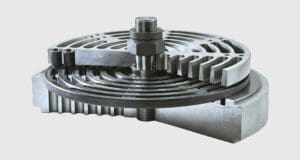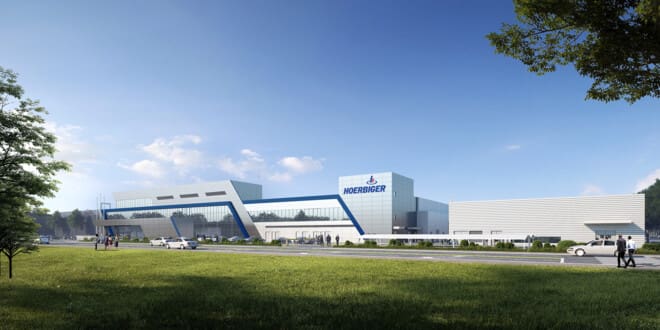Hoerbiger broke ground on a new manufacturing plant in Changzhou, China. The facility has expected completion by the end of 2023 and will serve as the headquarters for Hoerbiger China’s compression division and its safety business unit. The company said the plant will have enough space for more than 250 employees and will be the manufacturing center for all products related to compression and safety in the region. “Hoerbiger opened its first production site in China more than 27 years ago and our production in Changzhou began in 2009,” said Wolfgang Sautter, CEO of Hoerbiger’s Compression Division. “We’re pleased to strengthen our commitment to our Chinese operations with this groundbreaking ceremony for our new Changzhou facility. China is one of our most important markets and continues to offer high potential for the long-term growth of our business in the region.”
Compression and safety are two of the company’s five divisions, the others being automotive, rotary, and engine. Compression is by far the company’s largest division, contributing to 41% of 2021 sales and making up 46% of employees as of 2021. The compression division serves the natural gas, process gas, air compression, refining, petrochemical, and pharmaceutical industries. The division’s products include valves, lubrication, control systems, rings and packing, emissions control panels, and various repair and field services. Hoerbiger is involved in small- and large-scale projects around the world, with China being an area of focus for compression and safety due to the country’s growing economy and infrastructure investments. Hoerbiger’s safety solutions include explosion protection systems through its IEP Technologies brand, static grounding systems through its Newson Gale brand, and engine safety. “Hoerbiger’s business engagement in China has recorded substantial growth in the past decades, which we want to continue,” said Zuwang Yang, head of Regional Unit China at Hoerbiger. “However, with our current infrastructure, we have reached the limits of our space requirements. The attractive offering and the support of the local government of Changzhou, as well as the synergies with other parts of our company, which are already based here, were decisive for the new location.”
Hoerbiger believes the construction of the new manufacturing plant should help the company achieve the long-term goals for its compression and safety divisions. “With the new plant, we will also be in the position to address future trends in the Chinese market,” said Sautter. “These trends include solutions for hydrogen mobility, for both emissions reductions and digitalization. Therefore, we count on our local expertise with local product development, sales, engineering, and production, which is close to our customers.”
Advancing The Energy Transition
Emissions reductions are a key area of focus for Hoerbiger. The company publicly supports emissions reductions and wants to help its customers meet stricter environmental standards while lowering operating costs. By developing better products and services, Hoerbiger believes it can help customers lower emissions for mechanical equipment, such as reciprocating compressors that generate unnecessary carbon dioxide (CO2) emissions when ineffectively used.

For example, Hoerbiger’s XP and CP profiled plate valves are meant to decrease fuel consumption, cut CO2 emissions, and improve efficiency. The company has developed PowerPEEK valve plates that have been shown to improve reliability and durability by reducing wear and increasing uptime. The reciprocating compressor valves can lower emissions and improve performance for traditional process and natural gas applications, but were also designed for green hydrogen applications, synthetic fuels, biogas, hydrogen transportation, and liquefied natural gas (LNG) boil off. New compression products and improved services for a wide variety of industries in the energy transition should help Hoerbiger address the needs of a developing nation like China, which is the world’s biggest investor in renewable energy, as well as Europe and North America, which are increasingly investing in hydrogen and other low-carbon fuels.
The Hydrogen Opportunity
In addition to its own investments, Hoerbiger has formed key partnerships that could help it play a growing role in delivering new compressor applications for the energy transition. In June 2022, Hoerbiger and Ariel announced an agreement to provide non-lube compressor solutions capable of fulfilling the hydrogen compression requirements of the future hydrogen mobility market such as public transportation, large fleet vehicles, private trucking companies, trains, boats/ships, and other high-volume, high-pressure vehicle fueling applications. Under the agreement, Hoerbiger will provide packaged compressor solutions as a component to high-volume/high-pressure fueling facilities using any source of hydrogen.
Ariel and Hoerbiger have worked together to leverage their combined research, development, design, material science, manufacturing, and assembly capabilities to provide compressor solutions required by many of the high-volume/high-pressure vehicle fueling projects in planning or realization stages around the world. Headquartered in Mt. Vernon, Ohio, Ariel has shipped more than 65,000 compressors with installations in more than 100 countries. Ariel compressors are used in myriad applications serving global energy markets, industrial gas markets, and compressed gas transportation, storage, and delivery. Like Hoerbiger, Ariel has a presence and partnerships in China and is focused on the energy transition through products like its Ultra-Low Emissions Packing with BTUU.
Blending The Old With The New
Hoerbiger’s facility expansion in China addresses the opportunity for capacity installations in a developing economy. However, it’s also an opportunity to see what compression applications are best suited to serve the Chinese energy mix.
Hydrogen gas compression, renewable natural gas compression, LNG compression, compressed natural gas, and natural gas compression are the primary cornerstones for growth in the industry. Each geography is different. The products and services that succeed regionally depend on the needs, incentives, existing infrastructure, subsidies, and investment available. The companies that serve and support legacy industries, while also offering solutions that work for emissions-focused customers and growing industries like hydrogen will be best suited to capture decades of growth.
Industry followers should pay attention to the results that come from the Hoerbiger and Ariel partnership, and then connect the dots between geographical expansions and new products and services. Following this money trail will paint a clearer picture of the best opportunities and the future direction of the gas compression industry.

















